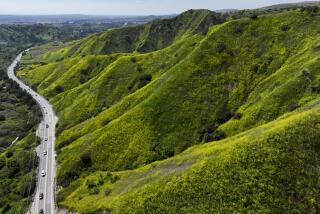State’s Dry Winter Casts Cloud Over Water Supply
- Share via
SAN FRANCISCO — Last week’s heavy rainstorms drenched commuters in Southern California and washed out roads in the northern part of the state, but they didn’t end the threat posed by California’s driest winter since the drought of 1977, state water officials said Wednesday.
With the Sierra Nevada snowpack still as low as 35% of normal in some key watershed areas, water officials are seeding clouds, buying out-of-state water, urging conservation and hoping for more rain. This year’s situation is far from a drought, but officials are planning now to cushion against the possibility of a second dry winter in 1988.
The rainy season officially ends March 31.
In Southern California, the Metropolitan Water District will buy extra water from the Colorado River, and the Los Angeles Department of Water and Power will spend an estimated $13 million for a share of it. In San Francisco this summer consumers may face their first restrictions on water use since 1977.
“The rain did us a lot of good but it didn’t pull us out of the hole,” said Bill Helms, a spokesman for the state Flood Operations Center in Sacramento. “If conditions continue normally, we’ll still be in a critically dry year.”
The state’s main storage reservoirs are at a normal level because of last week’s rain, Helms said. But the snowpack--which gradually melts to refill reservoirs over the spring and summer--remains only half of what it should be now across the state.
Worried by an early dry spell, in December the Department of Water Resources warned its 30 regional contractors to expect only 2.25 million acre-feet of water in 1987 from the state water project--almost 20% less than the 2.7 million they had requested. One acre-foot equals the amount of water that would cover one acre to a depth of one foot, or 326,000 gallons.
The Metropolitan Water District of Southern California, serving an area from Ventura to the Mexican border, arranged to obtain extra water from the Colorado River, which usually provides half the district’s water.
“We’re very, very lucky in that the Colorado River is running unusually high and we’ll be able to take over 1 million acre-feet from the Colorado,” said Jay Malinowski, a water district spokesman. “That’s almost double what we would otherwise take.”
The Los Angeles Department of Water and Power, which receives about 75% of its water from the eastern Sierra Nevada range, responded to the dry winter by starting its first cloud-seeding project since 1977 in January.
16 Seeding Flights
The department’s contractors have made 16 seeding flights so far, including several during last week’s storm, said Mitchell Kodama, a department engineer. But the snowpack from which the city draws its water--estimated before the storm at 25% of its normal level--is still only at 40% of normal.
“If the weather is normal for the rest of the season, we’re looking at around 60% of normal for the (summer) runoff,” Kodama said.
The department plans to make up for limited Sierra Nevada water with increased pumping of ground water from Inyo County and with a 50% increase in its water purchase from the Metropolitan Water District, Kodama said. The extra water district purchase could cost Los Angeles consumers an additional $13 million, he said. Kodama said the amount would be reflected on bills, but would be a relatively small amount when spread among the 600,000 households and businesses served by DWP.
In Orange County, where at least 75% of the water is imported, rainfall has been 31% below normal levels, said Nereus L. Richardson, acting secretary-manager of the Orange County Water District.
With water expected to be in short supply from MWD and the State Water Project, Richardson said in a letter to the district’s board of directors that OCWD may find itself having to resort to pumping record amounts of water from ground water basins.
“It will be much easier on everyone if we receive above normal rainfall for the remainder of the season,” Richardson said. “However, with the thought of an impending drought, the question of who gets the available amount of water, and when, will certainly be an issue this summer.”
Like Los Angeles, San Francisco faces a watershed which has had only 40% of its usual rain and snowfall. With normal rainfall through March, the city will end up with 75% of the usual level, which should be adequate, said Dean W. Coffey, general manager of Hetch Hetchy Water and Power.
Curtailed Water Use
But if the skies stay clear for the next month, San Francisco may have to curtail its water use by as much as 20% or 25%, Coffey said.
The San Francisco Water Department has begun planning how to implement limits on water use, said Robert Vasconcellos, the department’s resource manager.
“Right now it’s contingency planning and keeping our fingers crossed” for more rain, Vasconcellos said.
Farmers in part of the San Joaquin Valley will have to pump more well water than usual this summer unless there is heavy rainfall from now on, said Chuck Abraham, head of the U.S. Bureau of Reclamation’s Central Valley operations.
Storage in Millerton Lake, which supplies water to farms from Fresno to Bakersfield, has dropped to 162,000 acre-feet from its usual 300,000 acre-feet of water, Abraham said. If the reservoir level falls below 135,000 acre-feet, farmers will have to turn to their own ground-water supplies.
More to Read
Sign up for Essential California
The most important California stories and recommendations in your inbox every morning.
You may occasionally receive promotional content from the Los Angeles Times.













